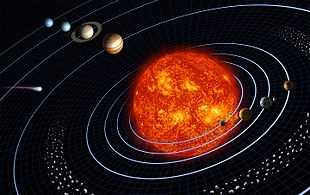Saturn
.jpg)
Saturn is studied using gaseous-object astronomy.
"Saturday is the day of Saturn, and the color of Saturn, according to astronomers, is said to be black".[1]
Planets
| Picture dictionary | |
|---|---|
|
|
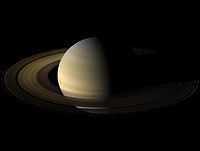
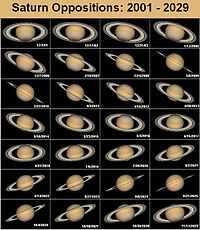
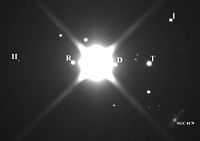
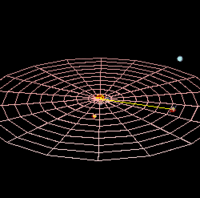
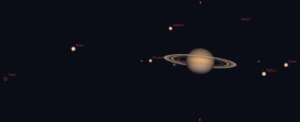
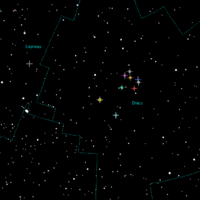
The picture dictionary display at the top of this section shows Saturn's approximate position in the Sol (or Sun) or the Solar System.
"The Saturn system experienced equinox, when the sun lies directly over a planet's equator and seasons change, in August 2009. (A full Saturn “year” is almost 30 Earth years.)"[2]
In the image on the right Saturn is about an Earth day and a half after equinox.
"In antiquity the classical planets were the non-fixed objects visible in the sky, known to various ancient cultures. The classical planets were therefore the Sun and Moon and the five non-earth planets of our solar system closest to the sun (and closest to the Earth); all easily visible without a telescope. They are Mercury, Venus, Mars, Jupiter, and Saturn."[3]
The second image down on the right shows how the position of the rings appears throughout an orbit of Saturn around the Sun.
In the third image down on the right, Saturn is apparent magnitude 0.8 in this image taken at 2010-03-04 11:45 UT. Saturn is overexposed to bring out fainter objects, including some members of the Saturn system.
Objects visible in this photo:
- Two bright background stars to the upper left of Saturn,
- Iapetus: 2 o'clock position (directly above NGC 4179 at 4 o'clock), labeled I,
- Titan: bright-outer moon (magnitude 8) at 3 o'clock, labeled T,
- Dione: 3 o'clock inner moon, labeled D,
- NGC 4179: 4 o'clock,
- Hyperion: faint-outer moon (magnitude 14) at 9 o'clock, labeled H,
- Rhea: inner moon at 9 o'clock, labeled R.
A simulation of the revolution of Saturn around the Sun is in the diagram which is the fourth image down on the right.
The fifth image down on the right and shows a stellarium simulation of Saturn and its major moons as they appeared on March 19, 2008.
"An orbital pole is either end of an imaginary line running through the center of an orbit perpendicular to the orbital plane, projected onto the celestial sphere. It is similar in concept to a celestial pole but based on the planet's orbit instead of the planet's rotation."[4]
"The north orbital pole of a celestial body is defined by the right-hand rule: If you curve the fingers of your right hand along the direction of orbital motion, with your thumb extended parallel to the orbital axis, the direction your thumb points is defined to be north."[4]
At right, sixth image down, is a snapshot of the planetary orbital poles.[5] The field of view is about 30°. The yellow dot in the centre is the Sun's North pole. Off to the side, the orange dot is Jupiter's orbital pole. Clustered around it are the other planets: Mercury in pale blue (closer to the Sun than to Jupiter), "Venus in green, [the] Earth in blue, Mars in red, Saturn in violet, Uranus in grey [partly underneath Earth] and Neptune in lavender. Dwarf planet Pluto is the dotless cross off in Cepheus."[4]
Some statistics on the orbit of Saturn around the Sun include
- size (semi-major axis): 1,426,666,422 km (9.53667594 A.U.),
- perihelion: 1,349,823,615 km,
- aphelion: 1,503,509,229 km,
- eccentricity: 0.05386179,
- circumference: 8,957,504,604 km,
- average velocity: 34,701 km/h,
- sidereal period: 29.447498 Earth years, 10,755.70 Earth days,
- inclination: 2.49 degrees, and
- equatorial inclination: 26.7 degrees.[6]
Theoretical Saturn
"Planets are believed to have formed through the accumulation of a large number of small bodies1, 2, 3, 4. In the case of the gas-giant planets Jupiter and Saturn, they accreted a significant amount of gas directly from the protosolar nebula after accumulating solid cores of about 5–15 Earth masses5, 6. Such models, however, have been unable to produce the smaller ice giants7, 8 Uranus and Neptune at their present locations, because in that region of the Solar System the small planetary bodies will have been more widely spaced, and less tightly bound gravitationally to the Sun."[7]
"When applied to the current Jupiter–Saturn zone, a recent theory predicts that, in addition to the solid cores of Jupiter and Saturn, two or three other solid bodies of comparable mass are likely to have formed9. [Model calculations] demonstrate that such cores will have been gravitationally scattered outwards as Jupiter, and perhaps Saturn, accreted nebular gas. The orbits of these cores then evolve into orbits that resemble those of Uranus and Neptune, as a result of gravitational interactions with the small bodies in the outer disk of the protosolar nebula."[7]
In the gaseous protoplanetary disk, the "mutual interactions between Jupiter and Saturn prevented [...] migration from driving these planets much closer to the Sun."[8]
"After a phase of inward runaway migration, Saturn was captured into the 2:3 mean motion resonance with Jupiter. At that point, the planets reversed their migration, moving outward in parallel, while preserving their resonant relationship."[8]
"In fact, after Jupiter and Saturn lock in their mutual 2:3 resonance, their outward migration is rather fast. Jupiter increases its orbital radius by ∼40% in 1000 orbits. If this really occurred in the Solar System, Jupiter would have been at some time in the middle of the asteroid belt. The properties of the asteroid belt (in particular the quite tight zoning of the taxonomic types) exclude this possibility."[8]
The "migration reversal [...] does not depend on the history of the previous migration."[8]
Arguments "favor [...] a close formation of Saturn [...] The direction of migration of Jupiter determines the subsequent evolution of both planets, once they are locked in resonance. The planets have to move in parallel to preserve the resonant configuration."[8]
"In most cases, the planets migrate outward, which is not a viable evolution in our Solar System, because it would imply that Jupiter was in the asteroid belt in the past. However, there is a range of values of viscosity and disk’s scale height such that, once in resonance, the planets have a quasi-stationary evolution during which their semi-major axes remain practically constant. We argue that Jupiter and Saturn actually followed this kind of evolution."[8]
Astrognosy
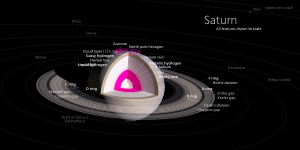
The internal structure of the gaseous giant Saturn is modeled on the right.
Electromagnetics
"The first systematic attempt to base a theory of the origin of the solar system on electromagnetic or hydromagnetic effects was made in Alfvén (1942). The reason for doing so was that a basic difficulty with the old Laplacian hypothesis: how can a central body (Sun or planet) transfer angular momentum to the secondary bodies (planets or satellites) orbiting around it? It was demonstrated that this could be done by electromagnetic effects. No other acceptable mechanism has yet been worked out. [...] the electromagnetic transfer mechanism has been confirmed by observations, as described in the monograph Cosmic Plasma (Alfvén, 1981, pp. 28, 52, 53 0."[9]
"If charged particles (electrons, ions or charged grains) move in a magnetic dipole field - strong enough to dominate their motion - under the action of gravitation and the centrifugal force, they will find an equilibrium in a circular orbit if their centrifugal force is 2/3 of the gravitational force [...] The consequence of this is that if they become neutralized, so that electromagnetic forces disappear, the centrifugal force is too small to balance the gravitation. Their circular orbit changes to an elliptical orbit with the semi-major axis a = 3/4a0 and e = 1/3 (where a0 is the central distance where the neutralization takes place [...] Collisional (viscous) interaction between the condensed particles will eventually change the orbit into a new circular orbit with a = 2/3a0 and e = 0."[9]
"If [...] there is plasma in the region [collisional interaction results in] matter in the 2/3-[region]. [...] matter in the region [...] will produce a [cosmogonic] shadow in the region".[9]
Weak forces
"Measurements taken by NASA's Cassini spacecraft have shown that the ringed planet might have a longer day than originally calculated from measurements taken by the Voyager 2 probe more than 20 years earlier."[10]
"While an uncertainty of 15 minutes may appear small compared to the approximately 10.5-hour rotation of Saturn, it is actually important to know [the rotation] accurately. The rotation period has an important effect on understanding Saturn's atmosphere dynamics and internal structure."[11]
"When Voyager 2 visited Saturn in 1981, the probe measured the planet's rotation period at about 10 hours, 39 minutes. But when Cassini first arrived at the planet in the early 2000s, it determined Saturn spun once on its axis every 10 hours and 47 minutes, and those numbers changed each time Cassini took a look."[10]
"Voyager and Cassini relied on measurements of the planet's radio radiation, but because those measurements shifted with each observation, they proved unreliable."[10]
"Radio radiation isn't the only method for studying the rotation of a gas giant. For planets where the magnetic field is tilted in relation to the axis the planet rotates around, measurements of the magnetic field can reveal how quickly the planet spins. However, Saturn's magnetic field lines up with its rotation axis, which prevents scientists from relying on that measure."[10]
"A third option involves measuring how long it takes for a cloud in Saturn's atmosphere to travel around the planet. But the rotation of the atmosphere doesn't necessarily line up with the rotation of the planet, making this method challenging."[10]
A "more mathematical approach [involves searching] for solutions for the rotation period by using coefficients to represent the interior, then [searching] for the rotation period that the most solutions calculated."[10]
"We did not want the derived period to be associated with a specific internal structure, so we accounted for many possibilities within their physical range. There are many solutions, but it was found that they tend to give a similar rotation period."[11]
"The theoretical estimate returned a rotation of almost 10 hours, 33 minutes."[10]
This is "in very good agreement with previous estimates that used different methods."[11]
"The newly returned calculation relied on studies of the planet's well-defined gravitational field. As Cassini traveled around the planet, it measured the tug of Saturn on the spacecraft, determining the strength or weakness of the gravitational pull."[10]
"The advantage of our method is that it is not associated with a specific interior model for Saturn, does not rely on the cloud-tracking wind properties that have large variability, and allows for the large range of solutions constrained by the measured physical properties of the planet and their uncertainties."[11]
"Saturn is rather thick around the middle, more than even Jupiter, which could indicate a fast spin. However, Helled pointed out that winds also affect oblateness, so strong winds around the equator could lead to a bigger bulge."[10]
"Such a rotation period for Saturn implies that the latitudinal wind structure is more symmetric, containing both easterly and westerly jets, like we see on Jupiter."[11]
Bands
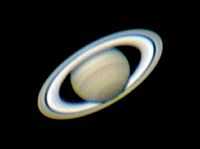
"The hydromagnetic approach led to the discovery of two important observational regularities in the solar system: (1) the band structure [such as in the rings of Saturn and in the asteroid belt], and (2) the cosmogonic shadow effect (the two-thirds fall down effect)."[9]
"Saturn's square shadow results in a similar fashion to the notorious 'black drop' effect observed during transits of the inferior planets, Mercury and Venus, across the face of the Sun."[12]
"It seems that the black drop is caused by a combination of telescopic or instrumental effects and the unsteadiness of the Earth's atmosphere, when observing the sharp, dark edge of a planet against the edge of a background source of light (the Sun)."[12]
"When Saturn's shadow falls on its rings near the principal gap, the Cassini division, the geometry and optical arrangement are such that the situation is the same as for the black drop effect, that is, a sharp planetary shadow meeting the abrupt edge of the bright background rings."[12]
Meteors
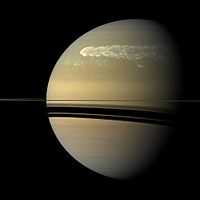
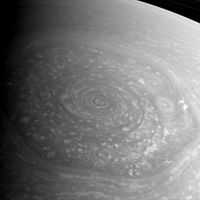
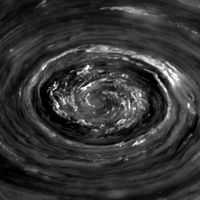
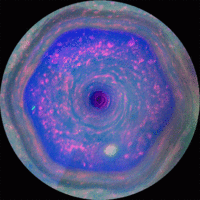
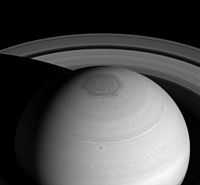
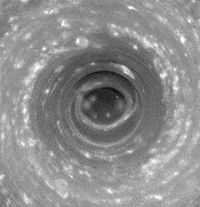
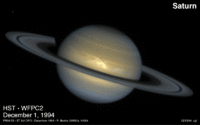
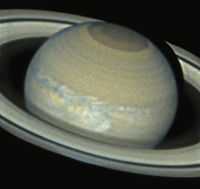
"[E]rosion from particles making up the icy rings of Saturn are forming rain water that falls on certain parts of the planet. ... tiny ice particles that compose the planet's distinctive rings are sometimes eroded away and then deposited in the planet's upper atmosphere. The droplets then create a kind of rain on the planet. ... charged water molecules rain down only on certain parts of the planet, which show up darker in infrared images. ... The magnetic connection creates a pathway for small ice particles in the rings to slough off into the planet's atmosphere, causing the "ring rain.""[13]
"The most surprising element to us was that these dark regions on the planet are found to be linked — via magnetic field lines — to the solid portions of water-ice within Saturn's ring-plane"[14].
"Saturn is the first planet to show significant interaction between its atmosphere and ring system ... The main effect of ring rain is that it acts to 'quench' the ionosphere of Saturn. In other words, this rain severely reduces the electron densities in regions in which it falls."[15]
"It turns out that a major driver of Saturn's ionospheric environment and climate across vast reaches of the planet are ring particles located some 36,000 miles [60,000 kilometers] overhead ... The ring particles affect both what species of particles are in this part of the atmosphere and where it is warm or cool."[16]
"Where Jupiter is glowing evenly across its equatorial regions, Saturn has dark bands where the water is falling in, darkening the ionosphere".[17]
A huge storm (great white spot) shown in the image on the right, churning through the atmosphere in Saturn's northern hemisphere overtakes its own trail in this true-color view from NASA’s Cassini spacecraft. Note that the trail of the disturbance in the atmosphere has apparently moved closer to the equator than the storm itself.
In the second image down on the right, the "Cassini spacecraft captures three magnificent sights at once: Saturn's north polar vortex and hexagon along with its expansive rings."[18]
"The hexagon, which is wider than two Earths, owes its appearance to the jet stream that forms its perimeter. The jet stream forms a six-lobed, stationary wave which wraps around the north polar regions at a latitude of roughly 77 degrees North."[18]
"This view looks toward the sunlit side of the rings from about 37 degrees above the ringplane. The image was taken with the Cassini spacecraft wide-angle camera on April 2, 2014 using a spectral filter which preferentially admits wavelengths of near-infrared light centered at 752 nanometers."[18]
"The view was obtained at a distance of approximately 1.4 million miles (2.2 million kilometers) from Saturn and at a Sun-Saturn-spacecraft, or phase, angle of 43 degrees. Image scale is 81 miles (131 kilometers) per pixel."[18]
In the third image down on the right "Cassini stares deep into the swirling hurricane-like vortex at Saturn's south pole, where the vertical structure of the clouds is highlighted by shadows. Such a storm, with a well-developed eye ringed by towering clouds, is a phenomenon never before seen on another planet."[19]
The image "shows a swirling cloud mass centered on the south pole, around which winds blow at 550 kilometers (350 miles) per hour. [...] The clouds inside the dark, inner circle are lower than the surrounding clouds, which cast a shadow that follows the sun."[19]
"The width of the shadow and the height of the sun above the local horizon yield a crude estimate of the height of the surrounding clouds relative to the clouds in the center. The shadow-casting clouds tower 30 to 75 kilometers (20 to 45 miles) above those in the center. This is two to five times greater than the tallest terrestrial thunderstorms and two to five times the height of clouds surrounding the eye of a terrestrial hurricane. Such a height difference arises because Saturn's hydrogen-helium atmosphere is less dense at comparable pressures than Earth's atmosphere, and is therefore more distended in the vertical dimension."[19]
"The south polar storm, which displays two spiral arms of clouds extending from the central ring and spans the dark area inside a thick, brighter ring of clouds, is approximately 8,000 kilometers (5,000 miles) across, which is considerably larger than a terrestrial hurricane."[19]
"Eye-wall clouds are a distinguishing feature of hurricanes on Earth. They form where moist air flows inward across the ocean's surface, rising vertically and releasing a load of precipitation around an interior circular region of descending air, which is the eye itself."[19]
"Though it is uncertain whether moist convection is driving this storm, as is the case with Earthly hurricanes, the dark 'eye' at the pole, the eye-wall clouds and the spiral arms together indicate a hurricane-like system. The distinctive eye-wall clouds especially have not been seen on any planet beyond Earth. Even Jupiter's Great Red Spot, much larger than Saturn's polar storm, has no eye, no eye-wall, and is relatively calm at the center."[19]
"This giant Saturnian storm is apparently different from hurricanes on Earth because it is locked to the pole, does not drift around like terrestrial hurricanes and because it does not form over liquid water oceans."[19]
"The images were acquired over a period of three hours on Oct. 11, 2006, when Cassini was approximately 340,000 kilometers (210,000 miles) from Saturn. Image scale is about 17 kilometers (11 miles) per pixel. The images were taken with the wide-angle camera using a spectral filter sensitive to wavelengths of infrared light centered at 752 nanometers. All frames have been contrast enhanced using digital image processing techniques. The unprocessed images show an oblique view toward the pole, and have been reprojected to show the planet from a perspective directly over the south pole."[19] "The upper clouds are composed of ammonia crystals"[20]
"In 1990, the Hubble Space Telescope imaged an enormous white cloud near Saturn's equator that was not present during the Voyager encounters and in 1994, another, smaller storm was observed. The 1990 storm was an example of a Great White Spot, a unique but short-lived phenomenon that occurs once every Saturnian year, roughly every 30 Earth years, around the time of the northern hemisphere's summer solstice.[21] Previous Great White Spots were observed in 1876, 1903, 1933 and 1960, with the 1933 storm being the most famous. If the periodicity is maintained, another storm will occur in about 2020.[22]"[20]
"Wind speeds on Saturn can reach 1,800 km/h (1,100 mph) ... Voyager data indicate peak easterly winds of 500 m/s (1800 km/h).[23]"[20]
"Infrared imaging has shown that Saturn's south pole has a warm polar vortex, the only known example of such a phenomenon in the Solar System.[24] Whereas temperatures on Saturn are normally −185 °C, temperatures on the vortex often reach as high as −122 °C, believed to be the warmest spot on Saturn.[24]"[20]
"A persisting hexagonal wave pattern around the north polar vortex in the atmosphere at about 78°N was first noted in the Voyager images.[25][26]"[20]
"This NASA Hubble Space Telescope image [fourth down on the right] of the ringed planet Saturn shows a rare storm that appears as a white arrowhead-shaped feature near the planet's equator. The storm is generated by an upwelling of warmer air, similar to a terrestrial thunderhead. The east-west extent of this storm is equal to the diameter of the Earth (about 7,900 miles). Hubble provides new details about the effects of Saturn's prevailing winds on the storm. The new image shows that the storm's motion and size have changed little since its discovery in September, 1994."[27]
"The storm was imaged with Hubble's Wide Field Planetary Camera 2 (WFPC2) in the wide field mode on December 1, 1994, when Saturn was 904 million miles from the Earth. The picture is a composite of images taken through different color filters within a 6 minute interval to create a "true-color" rendition of the planet. The blue fringe on the right limb of the planet is an artifact of image processing used to compensate for the rotation of the planet between exposures."[27]
"The Hubble images are sharp enough to reveal that Saturn's prevailing winds shape a dark "wedge" that eats into the western (left) side of the bright central cloud. The planet's strongest eastward winds (clocked at 1,000 miles per hour from analysis of Voyager spacecraft images taken in 1980-81) are at the latitude of the wedge."[27]
"To the north of this arrowhead-shaped feature, the winds decrease so that the storm center is moving eastward relative to the local flow. The clouds expanding north of the storm are swept westward by the winds at higher latitudes. The strong winds near the latitude of the dark wedge blow over the northern part of the storm, creating a secondary disturbance that generates the faint white clouds to the east (right) of the storm center."[27]
"The storm's white clouds are ammonia ice crystals that form when an upward flow of warmer gases shoves its way through Saturn's frigid cloud tops. This current storm is larger than the white clouds associated with minor storms that have been reported more frequently as bright cloud features."[27]
"Hubble observed a similar, though larger, storm in September 1990, [sixth image down on the right] which was one of three major Saturn storms seen over the past two centuries. Although these events were separated by about 57 years (approximately 2 Saturnian years) there is yet no explanation why they apparently follow a cycle -- occurring when it is summer in Saturn's northern hemisphere."[27]
Electrons
"[M]agnetospheric electron (bi-directional) beams connect to the expected locations of Saturn’s aurora".[28]
X-rays
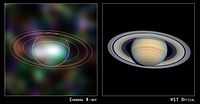
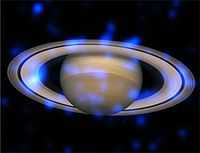
The X-ray astronomy image of Saturn is on the left in the composite at right. The Chandra X-ray Observatory "image of Saturn held some surprises for the observers. First, Saturn's 90 megawatts of X-radiation is concentrated near the equator. This is different from a similar gaseous giant planet, Jupiter, where the most intense X-rays are associated with the strong magnetic field near its poles. Saturn's X-ray spectrum, or the distribution of its X-rays according to energy, was found to be similar to that of X-rays from the Sun. This indicates that Saturn's X-radiation is due to the reflection of solar X-rays by Saturn's atmosphere. The intensity of these reflected X-rays was unexpectedly strong. ... The optical image of Saturn is also due to the reflection of light from the Sun - visible wavelength light in this case - but the optical and X-ray images obviously have dramatic differences. The optical image is much brighter, and shows the beautiful ring structures, which were not detected in X-rays. This is because the Sun emits about a million times more power in visible light than in X-rays, and X-rays reflect much less efficiently from Saturn's atmosphere and rings."[29]
"[T]he soft X-ray emissions of Jupiter (and Saturn) can largely be explained by scattering and fluorescence of solar X-rays."[30]
The second image at the right, "taken by the Chandra x-ray telescope, reveals that the rings of Saturn sparkle; in this x-ray/optical composite, they are visible as blue dots. This radiation’s source is likely fluorescence caused by solar x-rays as they strike oxygen atoms in the water molecules of the planet’s icy rings. As the image shows, most of the ring’s x-rays originate in the B ring—the bright white inner ring visible in this optical image—which is approximately 25,000 kilometers wide and 40,000 kilometers above the planet’s surface. X-rays may also be concentrated on Saturn’s left side, possibly because of their association with shadows in the planet’s rings that are known as spokes, or possibly as a result of the additional solar fluorescence caused by the transient ice clouds that produce spokes. Other Chandra observations of Saturn show that the x-ray brightness of the rings varies significantly from one week to the next."[31]
Ultraviolets

.ogv.jpg)
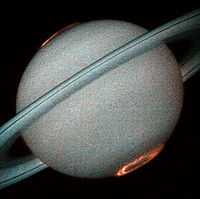
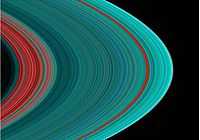
"One of a series, this image [at right] of Saturn was taken when the planet's rings were at their maximum tilt of 27 degrees toward Earth. Saturn experiences seasonal tilts away from and toward the sun, much the same way Earth does. This happens over the course of its 29.5-year orbit. Every 30 years, Earth observers can catch their best glimpse of Saturn's south pole and the southern side of the planet's rings. ... NASA's Hubble Space Telescope [captured detailed images of Saturn's Southern Hemisphere and the southern face of its rings."[32]
The movie at right records Saturn "when its rings were edge-on, resulting in a unique movie featuring the nearly symmetrical light show at both of the giant planet's poles. It takes Saturn almost thirty years to orbit the Sun, with the opportunity to image both of its poles occurring only twice during that time. The light shows, called aurorae, are produced when electrically charged particles race along the planet's magnetic field and into the upper atmosphere where they excite atmospheric gases, causing them to glow. Saturn's aurorae resemble the same phenomena that take place at the Earth's poles."[33]
"Powered by the Saturnian equivalent of (filamentary) Birkeland currents, streams of charged particles from the interplanetary medium interact with the planet's magnetic field and funnel down to the poles.[34] Double layers are associated with (filamentary) currents,[35][36] and their electric fields accelerate ions and electrons.[37]"[38]
"Towering more than 1,000 miles above the cloud tops, these Saturnian auroral displays are analogous to Earth's. ... In this false color image, the dramatic red aurora identify emission from atomic hydrogen, while the more concentrated white areas are due to hydrogen molecules."[39]
"The best view of Saturn's rings in the ultraviolet indicates there is more ice toward the outer part of the rings, than in the inner part, hinting at the origins of the rings and their evolution."[40]
"Images taken during the Cassini spacecraft's orbital insertion on June 30 show compositional variation in the A, B and C rings. From the inside out, the "Cassini Division" in faint red at left is followed by the A ring in its entirety. The Cassini Division at left contains thinner, dirtier rings than the turquoise A ring, indicating a more icy composition. The red band roughly three-fourths of the way outward in the A ring is known as the Encke gap."[40]
"The ring system begins from the inside out with the D, C, B and A rings followed by the F, G and E rings. The red in the image indicates sparser ringlets likely made of "dirty," and possibly smaller, particles than in the icier turquoise ringlets."[40]
The image at right "was taken with the Ultraviolet Imaging Spectrograph instrument, which is capable of resolving the rings to show features up to 97 kilometers (60 miles) across, roughly 100 times the resolution of ultraviolet data obtained by the Voyager 2 spacecraft."[40]
The image at second left Saturn's northern UV auroras. These exhibit changes in shape over the course of the observing interval.
"Saturn’s magnetosphere -- the big magnetic bubble that surrounds the planet -- is compressed on the side facing the sun, and it streams out into a long “magnetotail” on the planet’s nightside. Just like with comets, the magnetotails of Earth and Saturn are made of electrified gas from the sun."[41]
"Now it appears that when strong bursts of particles from the sun hit Saturn, the magnetotail collapses and then reconfigures itself -- a disturbance of the magnetic field that’s reflected in the dynamics of auroras."[41]
“We have always suspected this was what also happens on Saturn. This evidence really strengthens the argument.”[42]
“We can see that the magnetotail is undergoing huge turmoil and reconfiguration, caused by buffering from solar wind. It’s the smoking gun that shows us that the tail is collapsing.”[42]
Opticals
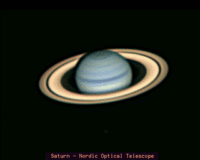
The image on the right of Saturn was taken with the 2.6 meter Nordic Optical Telescope, located at La Palma, Canary Islands.
The optical image shows the blue color of Saturn's northern hemisphere.
Visuals

"This image from NASA's Hubble Space Telescope shows Saturn's Southern Hemisphere and the southern face of its rings in visible light."[43]
"Saturn experiences seasonal tilts away from and toward the Sun, much the same way Earth does, over the course of its 29.5-year orbit. This means that approximately every 30 years, we can catch Saturn with its rings at their maximum tilt of 27 degrees toward Earth and get the best glimpse of Saturn's South Pole and the southern side of the planet's rings."[43]
Violets
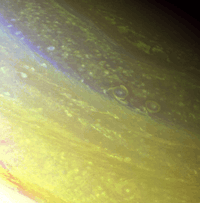
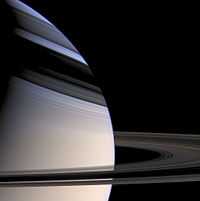
"The north polar region of Saturn is pictured in great detail in this Voyager 2 image obtained Aug. 25 from a range of 633,000 kilometers (393,000 miles)."[44]
"Two oval cloud systems some 250 km (150 mi) across are visible at about 72 degrees north latitude. The bright spot in the center of the leftmost cloud is a convective cloud storm about 60 km. (37 mi.)across. The outer ring of material rotates in an anti-cyclonic sense(counterclockwise in the northern hemisphere). A similar cloud structure of comparable dimension appears at 55 degrees north (bottom center of this picture). These northern latitudes contain many bright, small-scale cloud spots--only a few tens of kilometers across--representative of convective cloud systems. Across the top of this image stretch several long, linear, wavelike features that may mark the northernmost east-flowing jet in Saturn's atmosphere."[44]
"In this orange-and-violet-image composite, the smallest features visible are about 16 km. (10 mi.) across."[44]
In the second image at right, "[t]he gas planet's subtle northward gradation from gold to azure is a striking visual effect that scientists don't fully understand. Current thinking says that it may be related to seasonal influences, tied to the cold temperatures in the northern (winter) hemisphere. Despite Cassini's revelations, Saturn remains a world of mystery."[45]
Blues
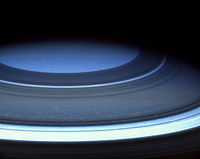
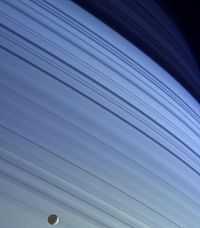
"Saturn's northern hemisphere [as shown in the first image on the right] is presently a serene blue [...] as seen in this natural color image from Cassini."[46]
"Images obtained using red, green and blue spectral filters were combined to create this color view. The images were taken with the Cassini spacecraft wide angle camera on Dec. 14, 2004, at a distance of 719,200 kilometers (446,900 miles) from Saturn. The image scale is about 39 kilometers (24 miles) per pixel."[46]
In the image second down on the right, "Mimas drifts along in its orbit against the azure backdrop of Saturn's northern latitudes in this true color view from NASA's Cassini spacecraft. The long, dark lines on the atmosphere are shadows cast by the planet's rings."[47]
Cyans
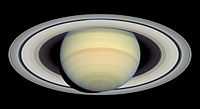
"The view [at right] from Hubble [of Saturn], taken on March 22, 2004, is so sharp that many individual Saturnian ringlets can be seen."[43]
"Hubble's exquisite optics, coupled with the high resolution of its Advanced Camera for Surveys, allow it to take pictures of Saturn which are nearly as sharp as Cassini's, even though Hubble is nearly a billion miles farther from Saturn than Cassini."[43]
"Camera exposures in four filters (blue, blue-green, green, and red) were combined to form the Hubble image, to render colors similar to what the eye would see through a telescope focused on Saturn. The subtle pastel colors of ammonia-methane clouds trace a variety of atmospheric dynamics. Saturn displays its familiar banded structure, and haze and clouds of various altitudes. Like Jupiter, all bands are parallel to Saturn's equator. Even the magnificent rings, at nearly their maximum tilt toward Earth, show subtle hues, which indicate the trace chemical differences in their icy composition."[43]
Greens
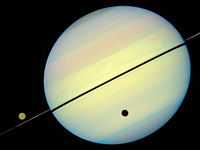

The image on the right shows natural greens in some of Saturn's bands and towards its edges from the Hubble Space Telescope.
"Saturn and its rings glow in a backlit, enhanced-color image [second image down on the right] from the Cassini orbiter. The picture combines images that were acquired using infrared, red and violet filters on Oct. 17. Two of Saturn's moons, Enceladus and Tethys, sparkle on the left side of the planet."[48]
"The Saturn picture, released today, marks the first time Cassini captured a backlit view of the ringed planet since 2006. That earlier photo made a huge splash, in part because the planet Earth could just barely be seen as a pale blue dot off to the side. This time, Earth is hidden behind Saturn, but you can spot two moons just to the left and below the planet: The closer speck is Enceladus, and Tethys is farther down and to the left."[48]
"The last time Cassini had such an unusual perspective on Saturn and its rings, at sufficient distance and with sufficient time to take a full mosaic of images of the entire system, occurred in September 2006 when it captured a mosaic of images, processed to look like natural color, entitled "In Saturn's Shadow-The Pale Blue Dot"."[49]
"The mosaic we are releasing today [18 December 2012] does not contain Earth: Along with the sun, our planet is hidden behind Saturn. However, it was taken when Cassini was closer to Saturn and therefore shows more detail in the rings than the one from six years ago. It also is displayed as it truly is, in false-color ... leaving a rather eerie and surreal impression on the viewer."[49]
Yellows
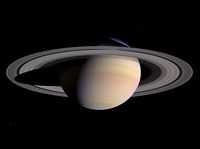
"The planet exhibits a pale yellow hue due to ammonia crystals in its upper atmosphere. ... [Its] exterior is predominantly composed of gas and it lacks a definite surface ... The planet primarily consists of hydrogen ... The outer atmosphere of Saturn contains 96.3% molecular hydrogen and 3.25% helium.[50] ... The proportion of helium is significantly deficient compared to the abundance of this element in the Sun.[51] ... Trace amounts of ammonia, acetylene, ethane, propane, phosphine and methane have been detected in Saturn's atmosphere.[52][53][54]"[20]
Oranges
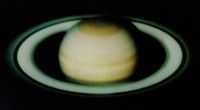
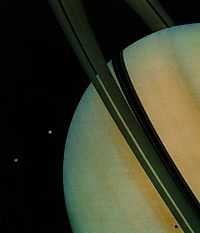
.jpg)
Early telescopic observations, i.e. pre-1979, as shown on the right revealed subdued browns of Saturn's upper atmosphere.
Later images from Pioneer 11 and Voyager 1 as the image on the left shows also exhibited subdued browns.
"A swing high above Saturn by NASA's Cassini spacecraft revealed this stately view of the golden-hued planet and its main rings. The view is in natural color, as human eyes would have seen it. This mosaic was made from 36 images in three color filters obtained by Cassini's imaging science subsystem on Oct. 10, 2013. The observation and resulting image mosaic were planned as one of three images for Cassini's 2013 Scientist for a Day essay contest."[55]
"Saturn sports differently colored bands of weather in this image [second down on the right]. For instance, a bright, narrow wave of clouds around 42 degrees north latitude appears to be some of the turbulent aftermath of a giant storm that reached its violent peak in early 2011. The mysterious six-sided weather pattern known as the hexagon is visible around Saturn's north pole."[55]
"When Cassini arrived in 2004, more of the northern hemisphere sported a bluish hue and it was northern winter. The golden tones dominated the southern hemisphere, where it was southern summer. But as the seasons have turned and northern spring is in full swing, the colors have begun to change in each hemisphere as well. Golden tones have started to dominate in the northern hemisphere and the bluish color in the north is now confined to a tighter circle around the north pole. The southern hemisphere has started getting bluer, too."[55]
Infrareds
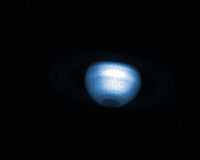
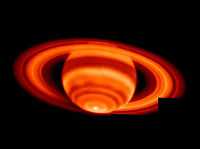
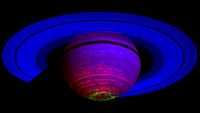
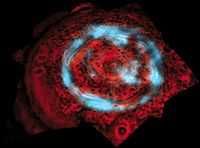
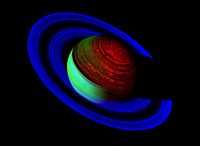
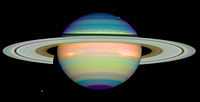
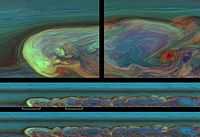
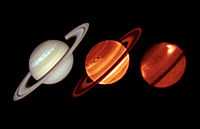
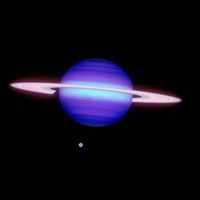
On the left is Saturn imaged by the Stockholm Infrared Camera (SIRCA) in the H2O infrared band to show the presence of water vapor. The image is cut off near the top due to the presence of Saturn's rings.
At right is an infrared astronomy image of Saturn. "This is the sharpest image of Saturn's temperature emissions taken from the ground; it is a mosaic of 35 individual exposures made at the W.M. Keck I Observatory, Mauna Kea, Hawaii on Feb. 4, 2004. The images to create this mosaic were taken with infrared radiation. The black square at 4 o'clock represents missing data."[56]
"In the most precise reading of Saturn's temperatures ever taken from Earth, a new set of infrared images suggests a warm "polar vortex" at Saturn's south pole - the first warm polar cap ever to be discovered in the solar system. The vortex is punctuated by a compact spot that is the warmest place on the planet."[57]
"The puzzle isn't that Saturn's south pole is warm; after all, it has been exposed to 15 years of continuous sunlight, having just reached its summer Solstice late in 2002. But both the distinct boundary of a warm polar vortex some 30 degrees latitude from the southern pole and a very hot "tip" right at the pole were completely unexpected. If the increased southern temperatures are the result of the seasonal variations of sunlight, then temperatures should increase gradually with increasing latitude. But they don't – the tropospheric temperature increases toward the pole abruptly near 70 degrees latitude from 88 to 89 Kelvin (- 301 to -299 degrees Fahrenheit) and then to 91 Kelvin (-296 degrees Fahrenheit) right at the pole. Near 70 degrees latitude, the stratospheric temperature increases even more abruptly from 146 to 150 Kelvin (-197 to -189 degrees Fahrenheit) and then again to 151 Kelvin (-188 degrees Fahrenheit) right at the pole."[57]
The second image at right is "constructed from data collected in the near-infrared wavelengths of light, the auroral emission is shown in green. The data represents emissions from hydrogen ions in of light between 3 and 4 microns in wavelength. In general, scientists designated blue to indicate sunlight reflected at a wavelength of 2 microns, green to indicate sunlight reflected at 3 microns and red to indicate thermal emission at 5 microns. Saturn's rings reflect sunlight at 2 microns, but not at 3 and 5 microns, so they appear deep blue. Saturn's high altitude haze reflects sunlight at both 2 and 3 microns, but not at 5 microns, and so it appears green to blue-green. The heat emission from the interior of Saturn is only seen at 5 microns wavelength in the spectrometer data, and thus appears red. The dark spots and banded features in the image are clouds and small storms that outline the deeper weather systems and circulation patterns of the planet. They are illuminated from underneath by Saturn's thermal emission, and thus appear in silhouette. The composite image was made from 65 individual observations by Cassini's visual and infrared mapping spectrometer on 1 November 2008. The observations were each six minutes long."[58]
The third image at right shows Saturn's northern polar region with "the aurora and underlying atmosphere, seen at two different wavelengths of infrared light as captured by NASA's Cassini spacecraft. Energetic particles, crashing into the upper atmosphere cause the aurora, shown in blue, to glow brightly at 4 microns (six times the wavelength visible to the human eye). The image shows both a bright ring, as seen from Earth, as well as an example of bright auroral emission within the polar cap that had been undetected until the advent of Cassini. This aurora, which defies past predictions of what was expected, has been observed to grow even brighter than is shown here. Silhouetted by the glow (cast here to the color red) of the hot interior of Saturn (clearly seen at a wavelength of 5 microns, or seven times the wavelength visible to the human eye) are the clouds and haze that underlie this auroral region."[59]
Also on the right is a fourth image of Saturn's north polar region in infrared. "This striking false-color mosaic was created from 25 images taken by Cassini's visual and infrared mapping spectrometer over a period of 13 hours, and captures Saturn in nighttime and daytime conditions. The visual and infrared mapping spectrometer acquires data simultaneously at 352 different wavelengths, or spectral channels. Data at wavelengths of 2.3, 3.0 and 5.1 microns were combined in the blue, green and red channels of a standard color image, respectively, to make this false-color mosaic."[60]
"This image was acquired on 24 February 2007, while the spacecraft was 1.58 million km (1 million miles) from the planet and 34.6 degrees above the ring plane. The solar phase angle was 69.5 degrees. In this view, Cassini was looking down on the northern, unlit side of the rings, which are rendered visible by sunlight filtering through from the sunlit, southern face."[60]
"On the night side (right side of image), with no sunlight, Saturn's own thermal radiation lights things up. This light at 5.1 microns wavelength (some seven times the longest wavelength visible to the human eye) is generated deep within Saturn, and works its way upward, eventually escaping into space. Thick clouds deep in the atmosphere block that light. An amazing array of dark streaks, spots and globe-encircling bands is visible instead. Saturn's strong thermal glow at 5.1 microns even allows these deep clouds to be seen on portions of the dayside (left side), especially where overlying hazes are thin and the glint of the sun off of them is minimal. These deep clouds are likely made of ammonium hydrosulfide and cannot be seen in reflected light on the dayside, since the glint of the sun on overlying hazes and ammonia clouds blocks the view of this level."[60]
"A pronounced difference in the brightness between the northern and southern hemispheres is apparent. The northern hemisphere is about twice as bright as the southern hemisphere. This is because high-level, fine particles are about half as prevalent in the northern hemisphere as in the south. These particles block Saturn's glow more strongly, making Saturn look brighter in the north."[60]
"At 2.3 microns (shown in blue), the icy ring particles are highly reflecting, while methane gas in Saturn's atmosphere strongly absorbs sunlight and renders the planet very dark. At 3.0 microns (shown in green), the situation is reversed: water ice in the rings is strongly absorbing, while the planet's sunlit hemisphere is bright. Thus the rings appear blue in this representation, while the sunlit side of Saturn is greenish-yellow in color. Within the rings, the most opaque parts appear dark, while the more translucent regions are brighter. In particular, the opaque, normally-bright B ring appears here as a broad, dark band separating the brighter A (outer) and C (inner) rings."[60]
"At 5.1 microns (shown in red), reflected sunlight is weak and thus light from the planet is dominated by thermal (i.e., heat) radiation that wells up from the planet's deep atmosphere. This thermal emission dominates Saturn's dark side as well as the north polar region (where the hexagon is again visible) and the shadow cast by the A and B rings. Variable amounts of clouds in the planet's upper atmosphere block the thermal radiation, leading to a speckled and banded appearance, which is ever-shifting due to the planet's strong winds."[60]
The fifth infrared image of Saturn is a detailed false color image. "[T]aken in January 1998 by the Hubble Space Telescope [it] shows the ringed planet in reflected infrared light. Different colors [indicate] varying heights and compositions of cloud layers generally thought to consist of ammonia ice crystals. The eye-catching rings cast a shadow on Saturn's upper hemisphere, while the bright stripe seen within the left portion of the shadow is infrared sunlight streaming through the large gap in the rings known as the Cassini Division."[61]
"Two of Saturn's many moons have also put in an appearance (in the full resolution version), Tethys just beyond the planet's disk at the upper right, and Dione at the lower left."[61]
The panoramic images at right "from NASA's Cassini spacecraft chronicle a day in the life of a huge storm that developed from a small spot that appeared 12 weeks earlier in Saturn's northern mid-latitudes."[62]
"This storm is the largest and most intense observed on Saturn by NASA's Voyager or Cassini spacecraft. The storm is still active. As seen in these and other Cassini images, the storm encircles the planet - whose circumference at these latitudes is 300,000 kilometres. From north to south, it covers a distance of about 15,000 kilometres, which is one-third of the way around the Earth. It encompasses an area of 4 billion square kilometres, or eight times the surface area of Earth. This storm is about 500 times the area of the biggest of the southern hemisphere storms ... observed by Cassini."[62]
"The highest clouds in the image are probably around 100 millibars pressure, 100 kilometres above the regular undisturbed clouds. These false colors show clouds at different altitudes. Clouds that appear blue here are the highest and are semitransparent, or optically thin. Those that are yellow and white are optically thick clouds at high altitudes. Those shown green are intermediate clouds. Red and brown colors are clouds at low altitude unobscured by high clouds, and the deep blue color is a thin haze with no clouds below. The base of the clouds, where lightning is generated, is probably in the water cloud layer of Saturn's atmosphere. The storm clouds are likely made out of water ice covered by crystallized ammonia."[62]
"Taken about 11 hours -- or one Saturn day -- apart, the two mosaics in the lower half of this image product consist of 84 images each. The mosaic in the middle was taken earlier than the mosaic at the bottom. Both mosaics were captured on Feb. 26, 2011, and each of the two batches of images was taken over about 4.5 hours."[62]
"Two enlargements from the earlier, middle mosaic are shown at the top of this product. The white lines below the middle mosaic identify those parts of the mosaic that were enlarged for these close-up views. The enlargement on the top left shows the head of the storm, and that on the top right shows the turbulent middle of the storm. Cassini observations have shown the head of the storm drifting west at a rate of about 2.8 degrees of longitude each Earth day (28 meters per second, or 63 miles per hour). The central latitude of the storm is the site of a westward jet, which means that the clouds to the north and south are drifting westward more slowly or even drifting eastward. In contrast, clouds at Saturn's equator drift eastward at speeds up to 450 meters per second (1,000 miles per hour). "[62]
"Both of the long mosaics cover an area ranging from about 30 degrees north latitude to 51 degrees north latitude. The views stretch from about 138 degrees west longitude on the left to 347 degrees west longitude on the right, passing through 360/0 degrees west longitude near the far right of the mosaics."[62]
"The images were taken with the Cassini spacecraft narrow-angle camera using a combination of spectral filters sensitive to wavelengths of near-infrared light. The images filtered at 889 nanometers are projected as blue. The images filtered at 727 nanometers are projected as green, and images filtered at 750 nanometers are projected as red."[62]
"The views were acquired at a distance of approximately 2.4 million kilometres from Saturn and at a sun-Saturn-spacecraft angle (phase angle) of 62 degrees. Both the top and bottom images are simple cylindrical map projections, defined such that a square pixel subtends equal intervals of latitude and longitude. At higher latitudes, the pixel size in the north-south direction remains the same, but the pixel size in the east-west direction becomes smaller. The pixel size is set at the equator, where the distances along the sides are equal. The images of the long mosaics have a pixel size of 53 kilometres at the equator, and the two close-up views have a pixel size of 9 kilometres per pixel at the equator."[62]
The seventh image down on the right shows thermal "infrared images of Saturn from the VISIR instrument on ESO’s VLT (centre and right) and an amateur visible-light image (left) from Trevor Barry (Broken Hill, Australia) obtained on 19 January 2011 during the mature phase of the northern storm. The second image is taken at a wavelength that reveals the structures in Saturn’s lower atmosphere, showing the churning storm clouds and the central cooler vortex. The third image is sensitive to much higher altitudes in Saturn’s normally peaceful stratosphere, where we see the unexpected beacons of infrared emission flanking the central cool region over the storm."[63] The two wavelengths are 18 µm and 8.6 µm.[63]
The eighth image down on the right shows a "Gemini North infrared image of Saturn and Titan (at about 6 o'clock position). Image obtained on May 7, 2009 (5:31 UTC) using the Altair adaptive optics system with the Near-infrared imager (NIRI). At the perimeter of Saturn's ring the F-ring is faintly visible. The F-ring was discovered in images from the Pioneer 11 spacecraft in 1979 and is normally not apparent in images taken with ground-based telescopes. Also apparent are several of Saturn's smaller moons. This color composite image made using data from three infrared filters (K' [2.0-2.1 microns], h210 [2.12 micron narrowband], and bracket gamma[2.17 micron narrowband]), the field of view is about 40 arcseconds across."[64]
Submillimeters
"[T]he PH3 1-0 rotational line (266.9 GHz) line [has been detected] in [the atmosphere of] Saturn".[65]
Radars
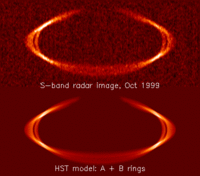
"Very low values of the radio brightness temperatures of the rings of Saturn indicate that their high radar reflectivity is not simply due to a gain effect in the backscatter direction. These two sets of observations are consistent with the ring particles having a very high single scattering albedo at radio wavelengths with multiple scattering effects being important. Comparison of scattering calculations for ice and silicate particles with radio and radar observations imply a mean particle radius of ~ 1 cm. [...] The inferred mean size is consistent with a model in which meteoroid impacts have caused a substantial reduction in the mean particle size from its initial value."[66]
"The image shown [on the right top] is a sum of 5 days of dual-circular polarization data, co-adding both polarizations. The Keplerian velocity profile of the rings results in the outermost or A ring which provides the earliest echo, appearing at a lower Doppler shift than the middle or B ring. This leads to four bright crossover regions on either side where signal from the two different rings add together, analogous to the north/south ambiguity for radar imaging of rigidly rotating bodies. A pronounced azimuthal asymmetry can be seen: the rings are brighter on the far quadrant on the receding (western) ansa than on the near quadrant of the approaching (eastern) ansa. The most widely accepted explanation of the asymmetry involves gravitational wakes generated by individual large ring particles, which are distorted by Keplerian shear into elongated structures trailing at angles of about 70 degrees from the radial direction (e.g. Franklin and Colombo 1978)."[67]
"A delay-Doppler image of Saturn's rings at a frequency of 2380 MHz (12.6 cm) is compared to a model image constructed by reprojecting a pair of HST images taken at 439 nm. Time delay increases from bottom to top, and Doppler shift increases from left to right. The effective spatial resolution is 2000 km by 15000 km."[67]
Radios
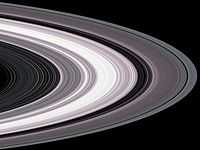
"Three simultaneous radio signals at wavelengths of 0.94, 3.6, and 13 centimeters (Ka-, X-, and S-bands) were sent from Cassini through the rings to Earth. The observed change of each signal as Cassini moved behind the rings provided a profile of the distribution of ring material and an optical depth profile."[68]
"This simulated image was constructed from the measured optical depth profiles of the Cassini Division and ring A. It depicts the observed structure at about 10 kilometers (6 miles) in resolution. The image shows the same ring A region depicted in a similar image (Multiple Eyes of Cassini), using a different color scheme to enhance the view of a remarkable array of over 40 wavy features called 'density waves' uncovered in the May 3 radio occultation throughout ring A."[68]
"Color is used to represent information about ring particle sizes based on the measured effects of the three radio signals. Shades of red [purple] indicate regions where there is a lack of particles less than 5 centimeters (about 2 inches) in diameter. Green and blue shades indicate regions where there are particles of sizes smaller than 5 centimeters (2 inches) and 1 centimeter (less than one third of an inch), respectively."[68]
"Note the gradual increase in shades of green towards the outer edge of ring A. It indicates gradual increase in the abundance of 5-centimeter (2-inch) and smaller particles. Note also the blue shades in the vicinity of the Keeler gap (the narrow dark band near the edge of ring A). They indicate increased abundance of even smaller particles of diameter less than a centimeter. Frequent collisions between large ring particles in this dynamically active region likely fragment the larger particles into more numerous smaller ones."[68]
Plasma objects
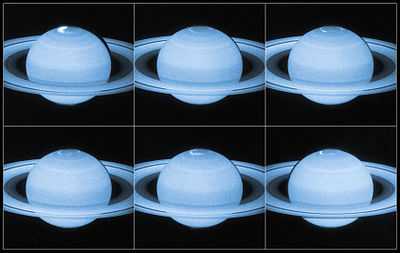
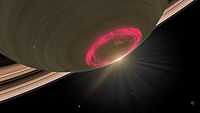
Astronomers using the NASA/ESA Hubble Space Telescope have captured new images of the dancing auroral lights at Saturn’s north pole shown in the images above.
"The ultraviolet images were taken by Hubble’s Advanced Camera for Surveys during April and May of last year from the space telescope’s perspective in orbit around Earth. The images are able to provide the first detailed look at dynamics in the “choreography” of auroral glow because Hubble captured them right at that very moment when Saturn’s magnetic field is blasted by particles streaming from the sun."[41]
"Hubble managed to capture a particularly dynamic light show: Some bursts of light shooting around the polar regions traveled at least three times faster than the speed of Saturn’s rotation. (The planet has a 10-hour rotation period.)"[41]
"Saturn's corona plays a major role in supplying hydrogen to the circumplanetary volume."[69]
"This cloud probably connects to the extended hydrogen corona of Saturn (Broadfoot et al., 1981; Shemansky and Hall, 1992) and to hydrogen-rich icy surfaces in the inner magnetosphere."[70]
Saturn's auroras are "magnificently tall, rising hundreds of miles above the planet’s poles. And unlike on Earth where bright displays fizzle after only a few hours, auroras on Saturn can shine for days."[71]
Gaseous objects
"Saturn is a gas giant".[20]
Atmospheres
"Light rays here travel a much longer path through the relatively cloud-free upper atmosphere. Along this path, shorter wavelength blue light rays are scattered effectively by gases in the atmosphere, and it is this scattered light that gives the region its blue appearance. Why the upper atmosphere in the northern hemisphere is so cloud-free is not known, but may be related to colder temperatures brought on by the ring shadows cast there."[46]
"Shadows cast by the rings surround the pole, looking almost like dark atmospheric bands. The ring shadows at higher latitudes correspond to locations on the ringplane that are farther from the planet--in other words, the northernmost ring shadow in this view is made by the outer edge of the A ring."[46]
"Spots of bright clouds also are visible throughout the region. This view is similar to an infrared image obtained by Cassini at nearly the same time (see PIA06567). The infrared view shows a great deal more detail in the planet's atmosphere, however."[46]
"Saturn's northern hemisphere is presently relatively cloud-free, and rays of sunlight take a long path through the atmosphere. This results in sunlight being scattered at shorter (bluer) wavelengths, thus giving the northernmost latitudes their bluish appearance at visible wavelengths."[47]
Prehistory
The prehistory period dates from around 7 x 106 b2k to about 7,000 b2k.
“Saturn has been known since prehistoric times.[72]”[20].
Mesolithic
The mesolithic period dates from around 13,000 to 8,500 b2k.
"All that we have considered up to now indicates that Saturn [Arka] once exploded in a nova-like burst of light. The date of this event I would be hard-put to specify, even approximately, but possibly it took place about ten thousand years ago. The solar system and reaches beyond it were illuminated by the exploded star, and in a matter of a week the Earth was enveloped in waters of Saturnian origin."[73]
Ancient history
The ancient history period dates from around 8,000 to 3,000 b2k.
Apparently 5102 b2k (before the year 2000.0), -3102 or 3102 BC, is the historical year assigned to a Hindu table of planets that does include the classical planet Saturn.[74] "Babylonian astronomy, too, had a four-planet system. In ancient prayers the planets Saturn, Jupiter, Mars, and Mercury are invoked; ... and one speaks of "the four-planet system of the ancient astronomers of Babylonia."[75]"[76]
“Babylonian astronomers systematically observed and recorded the movements of Saturn.[77]”[20].
“Ancient Chinese and Japanese culture designated the planet Saturn as the earth star”[20].
“In ancient Hebrew, Saturn is called 'Shabbathai'.[78] Its angel is Cassiel. Its intelligence or beneficial spirit is Agiel (layga) and its spirit (darker aspect) is Zazel (lzaz).”[20].
“In Ottoman Turkish, Urdu and Malay, its name is 'Zuhal'”[20].
Anu
Anu may be an early Sumerian, Akkadian, and Babylonian name for Saturn.
"An, the oldest and highest of the Sumero-Babylonian gods, whose primordial age was "the year of abundance," signified Saturn, according to Jensen.6"[79]
Baal-hamon
"The potential cruelty of Saturn was enhanced by his identification with Cronus, known for devouring his own children. He was thus equated with the Carthaginian god Ba'al Hammon, to whom children were supposedly sacrificed. Saturn was also among the gods the Romans equated with Yahweh, whose Sabbath (on Saturday) he shared as his holy day."[80]
"Modern scholars identify [Baal-hamon] variously with the Northwest Semitic god El or with Dagon.[81]"[82]
"Ancient Greek writers identified him with the Titan Cronus. In ancient Rome, he was identified with Saturn"[82].
Brahma
"The Hindu Brahma, Yama, Vishnu, and Manu converge as representatives of a solitary supreme god and creator governing a lost paradise as the first king, setting forth the first moral codes, and imparting to mankind the fundamentals of civilization."[20]
Cronus
“The Greeks had made the outermost planet sacred to Cronus,[83] and the Romans followed suit.”[20].
El
"In the Canaanite religion, or Levantine religion as a whole, Ēl or Il was the supreme god, the father of humankind and all creatures and the husband of the goddess Asherah as recorded in the clay tablets of Ugarit ... The noun ʾēl was found at the top of a list of gods as the "Ancient of gods" or the "Father of all gods", in the ruins of the royal archive of the Ebla civilization, in the archaeological site of Tell Mardikh in Syria dated to 2300 BC."[84]
"Ēl (rendered Elus or called by his standard Greek counterpart Cronus) is not the creator god or first god. Ēl is rather the son of Sky and Earth."[84]
"Joseph Fontenrose first demonstrated that, whatever their deep origins, at Ugarit Dagon was identified with El,[85]"[86]
Osiris
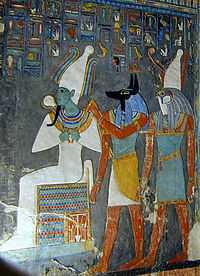
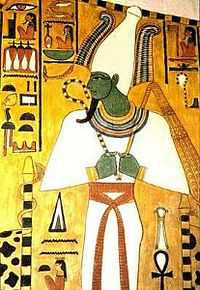
"Osiris is the mythological father of the god Horus, whose conception is described in the Osiris myth, a central myth in ancient Egyptian belief. The myth described Osiris as having been killed by his brother Seth, who wanted Osiris' throne. Isis joined the fragmented pieces of Osiris, but the only body part missing was the phallus. Isis fashioned a golden phallus, and briefly brought Osiris back to life by use of a spell that she learned from [Geb] her father. This spell gave her time to become pregnant by Osiris before he again died. Isis later gave birth to Horus. As such, since Horus was born after Osiris' resurrection, Horus became thought of as a representation of new beginnings and the vanquisher of the evil Set."[87]
"The Phoenician El - Saturn - has four eyes, as does the Orphic Kronos (Saturn)."[79]
"The Chinese Yellow Emperor Huang-ti--identified as Saturn--is also four-eyed.74"[79]
"Osiris, as the Ram of Mendes, is the god of "four faces on one neck."62"[79]
Have observers recorded images of sky entities in the green?
Romulus
Def. in Roman mythology, "[t]he legendary founder of Rome and the twin brother of Remus"[88] is called Romulus.
"Ioannes the Lydian, writing in the sixth century on the usage of his native town, says: 'Our own Philadelpheia still preserves a trace of the ancient belief. On the first day of the month (sc. January) there goes in procession no less a personage than Ianus himself, dressed up in a two-faced mask, and people call him Saturnus, identifying him with Kronos2.'"[2]
"The twins [Romulus and Remus], as in the case of Janus, attach themselves to the Universal Monarch as his two faces, looking in opposite directions."[79]
Saturnus
“In ancient Roman mythology, the god Saturnus, from which the planet takes its name, was the god of agriculture.[89] The Romans considered Saturnus the equivalent of the Greek god Cronus.[89]”[20].
“The Latins considered Saturn the predecessor of Jupiter. Saturn reigned in Latium during a mythical Golden Age reenacted every year at the festival of Saturnalia. Saturn also retained primacy in matters of agriculture and money. Unlike the Greek tradition of Cronus and Zeus, the usurpation of Saturn as king of the gods by Jupiter was not viewed by the Latins as violent or hostile; Saturn continued to be revered in his temple at the foot of the Capitol Hill, which maintained the alternative name Saturnius into the time of Varro.[90]”[91]
God
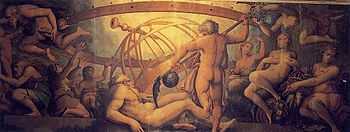
"There is one God, greatest among gods and men, neither in shape nor in thought like unto mortals ... He abides ever in the same place motionless, and it befits him not to wander hither and thither."[92]
"Saturn, the old man who lives at the north pole, and brings with him to the children of men a sprig of evergreen (the Christmas tree), is familiar to the little folks under the name Santa Claus, for he brings each winter the gift of a new year."[93]
"The religions of all ancient nations ... associate the abode of the supreme God with the North Pole, the centre of heaven; or with the celestial space immediately surrounding it."[94]
"Lenormant, speaking of Rome and Olympia, remarks, "It is impossible not to note that the Capitoline was first of all the Mount of Saturn, and that the Roman archaeologists established a complete affinity between the Capitoline and Mount Cronios in Olympia, from the standpoint of their traditions and religious origin (Dionysius Halicarn., i., 34). This Mount Cronios is, as it were, the Omphalos of the sacred city of Elis, the primitive centre of its worship. It sometimes receives the name Olympos."1 Here is not only symbolism in general, but also a symbolism pointing to the Arctic Eden, already shown to be the primeval mount of Kronos, the Omphalos of the whole earth.2"[94]
"As an offshoot of these Hellenistic speculations we should place Tacitus, Histories V,2: "Iudaeos Creta insula profugos novissima Libyae insedisse memorant, qua tempestate Saturnus vi Jovis pulsus cesserit regnis" (quoted from Loeb Classical Library)."[95] i.e., "Jews were fugitives from the island of Crete and settled in Libya recorded the time when Saturn was driven from his throne by force of Jupiter".[95]
"The motif of Saturn handing over power to Jupiter derives, of course, from Hesiod's account of the succession of the gods in his Theogony, and his story of the five successive ages of men -- the first, or golden, age being under the reign of Kronos (Saturn) and the following ages being under the reign of Zeus (Jupiter) -- in his Works and Days (110ff.). These stories were often retold. Ovid, for example, combines in his Metamorphoses the stories in the Theogony and Works and Days, telling us how, "when Saturn was consigned to the darkness of Tartarus, and the world passed under the rule of Jove, the age of silver replaced that of gold."8"[96]
The image on the right is a painting by artist Giorgio Vasari (1511–1574). The main focus is on Cronus (Saturn) castrating Uranus (the Greek sky god). As both Uranus and Cronus are represented by men, this suggests that they were similar in nature.
Early history

The early history period dates from around 3,000 to 2,000 b2k.
"Krishna ... is the [Daśāvatāra] eighth [avatar] incarnation of Lord Vishnu in Hinduism. ... Worship of the deity Krishna, either in the form of Vasudeva, Bala Krishna or Gopala can be traced to as early as 4th century BC.[97][98] ... He is often shown wearing a yellow silk dhoti and a peacock feather crown. ... The Harivamsa describes intricate relationships between Krishna Vasudeva, Sankarsana, Pradyumna and Aniruddha that would later form a Vaishnava concept of primary quadrupled expansion, or avatar.[99]"[100]
"The Hindu Atharva Veda speaks of the "four heavenly directions, having the wind as lord, upon which the sun looks out."63 This, of course, can only be the central sun, who is Brahma, a god of four faces. The myths also attribute four faces to Shiva.64 The central sun Prajapati takes the form of the four-eyed, four-faced, and four-armed Vivvakarman, the "all maker".65 Agni, too, faces "in all directions,"66 as does Krishna.67 ... There can no longer be any doubt that the four-eyed or four-faced god is Saturn, for the sun-planet appears in Babylonian myth as Ea (Sumerian Enki)-a god of four eyes that "behold all things."73"[79]
Classical history
The classical history period dates from around 2,000 to 1,000 b2k.
Pliny the Elder published Naturalis Historia circa 77-79 AD (1923-1921 b2k).
"68. Cf. PL. [Pliny the Elder], II, 138-139; SERV. [Servius], ad VERG., Aen., I, 42; XI, 259. Les foudres de Saturne sont des foudres d'hiver, ce qui correspond á la date de sa fête et plus fondamentalement aux liens entre cette divinité et l'aspect de [...] crise [...] de l'année que représente cette saison."[101] on page 151. This footnote may translate from the French to read: The thunderbolts (lightning) of Saturn are winter thunderbolts which correspond to the date of his birthday and more fundamentally to the links between this deity and the appearance of the annual crisis that represents this season.
"Ptolemy observed an opposition of Saturn A. D. 127 [1873 b2k], which was the basis for his determination of the elements of its orbit."[102]
Recent history
_01.jpg)

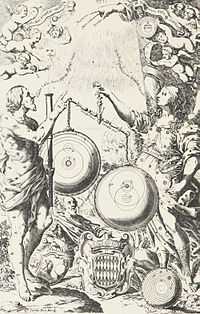


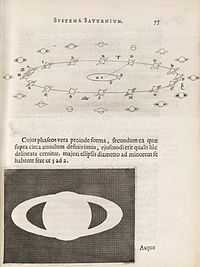

.jpg)

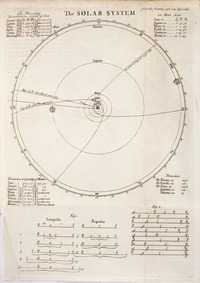
The recent history period dates from around 1,000 b2k to present.
The Franco-Flemish painting on the right has God the Father with a halo, dated to circa 1380 (620 b2k).
On the left is the frontispiece "of Riccioli's 1651 New Almagest. [In it mythological] figures observe the heavens with a telescope and weigh the heliocentric theory of Copernicus in a balance against his modified version of Tycho Brahe's geo-heliocentric system, in which the Sun, Moon, Jupiter and Saturn orbit the Earth while Mercury, Venus, and Mars orbit the Sun. The old Ptolemaic geocentric theory lies discarded on the ground, made obsolete by the telescope's discoveries. These are illustrated at top and include phases of Venus and Mercury and a surface feature on Mars (left), moons of Jupiter, rings of Saturn, and features on the moon (right). The balance tips in favor of Riccioli's "Tychonic" system."[103]
In the second image down on the right, God the Father has a dark halo. Dated circa 4th quarter of the 15th century (1475-1500, 525-500 b2k).
The third image down on the right is dated circa 1480-1490 (520-510 b2k) with God the Father having an apparent halo in white.
The second figure on the left contains Huygens Systema Saturnium. The top diagram shows how Saturn's appearance to us changes due the changing positions of the Earth (E) and Saturn as they orbit the Sun (G). The bottom portion contains Huygens observation of Saturn presenting its rings to us at their greatest inclination. Both parts date from 1659, 341 b2k.
In the fourth image down on the right, Michelangelo painted God in white with some green nearby, dated to 1508-1512 (492-588 b2k).
The fifth image down on the right has God the Father painted in white by Ludovico Mazzolino, dated to from 1510 until 1520 (490-480 b2k). The halo is gone but it appears a bald head replaces the disk of Saturn.
The third page down on the left is dated to 1661, 339 b2k, and describes the theory of Ptolemy.
The sixth image down on the right dated to circa 1635-1640 has God the Father with a whitish bald head partially surrounded with whitish hair.
The fourth page on the left is a chart of the Solar System up to the orbit of the planet Saturn. The tracks of three comets are indicated, which appeared in the years 1662, 1680 and 1682, respectively. The page is dated to 1727, 273 b2k.
Research
Hypothesis:
- If Saturn was a pole star for the Earth while in orbit around the Sun in recorded history, the astronomical observations of the time should record this in some way.
Control groups

The findings demonstrate a statistically systematic change from the status quo or the control group.
“In the design of experiments, treatments [or special properties or characteristics] are applied to [or observed in] experimental units in the treatment group(s).[104] In comparative experiments, members of the complementary group, the control group, receive either no treatment or a standard treatment.[12]"[105]
Proof of concept
Def. a “short and/or incomplete realization of a certain method or idea to demonstrate its feasibility"[106] is called a proof of concept.
Def. evidence that demonstrates that a concept is possible is called proof of concept.
The proof-of-concept structure consists of
- background,
- procedures,
- findings, and
- interpretation.[107]
See also
References
- ↑ Glenn D. Lowry (1987). "Humayun's Tomb: Form, Function, and Meaning in Early Mughal Architecture". Muqarnas 4: 133-48. doi:10.2307/1523100. http://www.jstor.org/stable/10.2307/1523100. Retrieved 2012-04-24.
- 1 2 Jia-Rui C. Cook, Joe Mason, and Michael Buckley (March 17, 2011). "Cassini Sees Seasonal Rains Transform Titan's Surface". Pasadena, California USA: NASA/JPL. Retrieved 2013-04-12.
- ↑ "Classical planets, In: Wikipedia". San Francisco, California: Wikimedia Foundation, Inc. 15 February 2014. Retrieved 2014-02-15.
- 1 2 3 "Orbital pole, In: Wikipedia". San Francisco, California: Wikimedia Foundation, Inc. December 17, 2012. Retrieved 2013-01-20.
- ↑ J. Herschel (June 1918). "The poles of planetary orbits". The Observatory 41: 255-7. http://adsabs.harvard.edu/full/1918Obs....41..255H. Retrieved 2013-07-10.
- ↑ Courtney O'Connor and Bill Dunford (3 August 2014). "Saturn: Facts & Figures". Washington, DC USA: NASA. Retrieved 2015-05-04.
- 1 2 Edward W. Thommes, Martin J. Duncan & Harold F. Levison (6 December 1999). "The formation of Uranus and Neptune in the Jupiter–Saturn region of the Solar System". Nature 402 (6762): 635-8. doi:10.1038/45185. http://www.nature.com/nature/journal/v402/n6762/full/402635a0.html. Retrieved 2015-05-04.
- 1 2 3 4 5 6 Alessandro Morbidelli and Aurélien Crida (2007). "The dynamics of Jupiter and Saturn in the gaseous protoplanetary disk". Icarus 191: 158-71. http://sirrah.troja.mff.cuni.cz/~mira/mp/tmp/diplomka2_j21/Morbidelli_Crida_2007_1-s2.0-S0019103507001480-main.pdf. Retrieved 2015-05-04.
- 1 2 3 4 Hannes Alfvén (October 1981). "The Voyager 1/Saturn Encounter and the Cosmogonic Shadow Effect". Astrophysics and Space Science 79 (2): 491-505. doi:10.1007/BF00649444. http://adsabs.harvard.edu/abs/1981Ap&SS..79..491A. Retrieved 2013-12-19.
- 1 2 3 4 5 6 7 8 9 Nola Taylor Redd (25 March 2015). "Length of Saturn's Day Measured Like Never Before". Space.com. Retrieved 2015-05-13.
- 1 2 3 4 5 Ravit Helled (25 March 2015). "Length of Saturn's Day Measured Like Never Before". Space.com. Retrieved 2015-05-13.
- 1 2 3 4 Mark Bailey, David Stewart and Mark Stronge (10 May 2005). "Saturn Yields More Secrets". College Hill, Armagh, BT61 9DG, UK: Armagh Observatory. Retrieved 2015-05-08.
- ↑ Miriam Kramer (April 10, 2013). "Saturn's Dazzling Rings Make It 'Rain'". Space.com. Retrieved 2013-04-12.
- ↑ James O'Donoghue (April 10, 2013). "Saturn's Dazzling Rings Make It 'Rain'". Space.com. Retrieved 2013-04-12.
- ↑ James O'Donoghue (April 10, 2013). "Blame it on the Rain (from Saturn's Rings)". Pasadena, California USA: NASA/JPL. Retrieved 2013-04-12.
- ↑ Kevin Baines (April 10, 2013). "Blame it on the Rain (from Saturn's Rings)". Pasadena, California USA: NASA/JPL. Retrieved 2013-04-12.
- ↑ Tom Stallard (April 10, 2013). "Blame it on the Rain (from Saturn's Rings)". Pasadena, California USA: NASA/JPL. Retrieved 2013-04-12.
- 1 2 3 4 Tony Greicius (8 July 2014). "Vortex and Rings". Retrieved 2015-04-29.
- 1 2 3 4 5 6 7 8 Susan Watanabe (09 November 2006). "Looking Saturn in the Eye". Washington, DC USA: NASA. Retrieved 2015-04-29.
- 1 2 3 4 5 6 7 8 9 10 11 12 13 14 15 "Saturn, In: Wikipedia". San Francisco, California: Wikimedia Foundation, Inc. February 20, 2013. Retrieved 2013-02-20.
- ↑ Pérez-Hoyos, S.; Sánchez-Laveg, A.; French, R. G.; J. F., Rojas (2005). "Saturn's cloud structure and temporal evolution from ten years of Hubble Space Telescope images (1994–2003)". Icarus 176 (1): 155–174. doi:10.1016/j.icarus.2005.01.014.
- ↑ Patrick Moore, ed., 1993 Yearbook of Astronomy, (London: W.W. Norton & Company, 1992), Mark Kidger, "The 1990 Great White Spot of Saturn", pp. 176–215.
- ↑ Hamilton, Calvin J. (1997). "Voyager Saturn Science Summary". Solarviews. Archived from the original on 2011-10-05. Retrieved 2007-07-05.
- 1 2 "Warm Polar Vortex on Saturn". Merrillville Community Planetarium. 2007. Archived from the original on 2011-10-05. Retrieved 2007-07-25.
- ↑ Godfrey, D. A. (1988). "A hexagonal feature around Saturn's North Pole". Icarus 76 (2): 335. doi:10.1016/0019-1035(88)90075-9.
- ↑ Sanchez-Lavega, A.; Lecacheux, J.; Colas, F.; Laques, P. (1993). "Ground-based observations of Saturn's north polar SPOT and hexagon". Science 260 (5106): 329. doi:10.1126/science.260.5106.329. PMID 17838249.
- 1 2 3 4 5 6 Reta Beebe, D. Gilmore, L. Bergeron (21 December 1994). "Hubble Observes a New Saturn Storm". Baltimore, Maryland USA: NASA, Space Science Institute. Retrieved 2015-05-01.
- ↑ J. Saur, B.H. Mauk, D.G. Mitchell, N. Krupp, K.K. Khurana, S. Livi, S.M. Krimigis, P.T. Newell, D.J. Williams, P.C. Brandt, A. Lagg, E. Roussos, and M.K. Dougherty (February 2006). "Anti-planetward auroral electron beams at Saturn". Nature 439 (7077): 699-702. doi:10.1038/nature04401.
- ↑ Samantha Harvey (August 19, 2008). "X-Ray Saturn". NASA. Retrieved 2012-07-21.
- ↑ G. Branduardi-Raymont, A. Bhardwaj, R.F. Elsner, G.R. Gladstone, G. Ramsay, P. Rodriguez, R. Soria, J.H. Waite Jr., T.E. Cravens (June 2007). "Latest results on Jovian disk X-rays from XMM-Newton". Planetary and Space Science 55 (9): 1126-34. doi:10.1016/j.pss.2006.11.017. http://arxiv.org/pdf/astro-ph/0609758. Retrieved 2013-05-23.
- ↑ Chandra X-ray Observatory Center (2003). "click! Photography Changes Everything". Cambridge, Massachusetts USA: Smithsonian Astrophysical Observatory. Retrieved 2014-05-31.
- ↑ Samantha Harvey (September 16, 2011). "In Ultraviolet Light". NASA. Retrieved 2012-07-21.
- ↑ Jonathan Nichols (February 11, 2010). "Double light show in a single shot: Hubble images both of Saturn's aurorae". NASA and Hubble Space Telescope. Retrieved 2012-07-21.
- ↑ Isbell, J.; Dessler, A. J.; Waite, J. H. "Magnetospheric energization by interaction between planetary spin and the solar wind" (1984) Journal of Geophysical Research, Volume 89, Issue A12, pp. 10715–10722
- ↑ Theisen, William L. "Langmuir Bursts and Filamentary Double Layers in Plasmas." (1994) Ph.D Thesis U. of Iowa, 1994
- ↑ Deverapalli, C. M.; Singh, N.; Khazanov, I. "Filamentary Structures in U-Shaped Double Layers" (2005) American Geophysical Union, Fall Meeting 2005, abstract #SM41C-1202
- ↑ Borovsky, Joseph E. "Double layers do accelerate particles in the auroral zone" (1992) Physical Review Letters (ISSN 0031-9007), vol. 69, no. 7, Aug. 17, 1992, pp. 1054–1056
- ↑ "Double layer (plasma), In: Wikipedia". San Francisco, California: Wikimedia Foundation, Inc. October 16, 2012. Retrieved 2012-11-16.
- ↑ Robert Nemiroff & Jerry Bonnell (December 23, 2001). "Saturn Aurora". Greenbelt, Maryland, USA: JPL, NASA GSFC. Retrieved 2012-11-16.
- 1 2 3 4 University of Colorado (July 9, 2004). "PIA05075: Saturn's A Ring From the Inside Out". Pasadena, California USA: NASA/JPL. Retrieved 2013-03-27.
- 1 2 3 4 Janet Fang (19 May 2014). "Hubble Captures Dancing Auroras on Saturn". IFLScience. Retrieved 2014-08-31.
- 1 2 Jonathan Nichols (19 May 2014). "Hubble Captures Dancing Auroras on Saturn". IFLScience. Retrieved 2014-08-31.
- 1 2 3 4 5 E. Karkoschka (9 September 2003). "The Slant on Saturn's Rings (Visible)". Baltimore, Maryland USA: NASA/ESA. Retrieved 2015-05-02.
- 1 2 3 Ciclops (August 25, 1981). "Saturn - north polar region (NASA Voyager Saturn Encounter Images)". Pasadena, California USA: NASA/JPL. Retrieved 2013-03-27.
- ↑ Enrico Piazza (December 22, 2005). "The Face of Beauty". Pasadena, California USA: NASA/JPL. Retrieved 2013-03-27.
- 1 2 3 4 5 Calvin J. Hamilton (14 December 2005). "Saturn's Blue Cranium". Pasadena, California USA: NASA/JPL/Space Science Institute. Retrieved 2015-05-01.
- 1 2 Jim Wilson (March 23, 2008). "Saturn's Blues". Pasadena, California USA: NASA/JPL. Retrieved 2013-03-27.
- 1 2 Carolyn Porco (18 December 2012). "Space missions deliver treats from Saturn and beyond". NBCNews. Retrieved 2015-05-08.
- 1 2 Carolyn Porco (18 December 2012). "Captain's Log". Cassini Imaging Central Laboratory for Operations. Retrieved 2015-05-08.
- ↑ Saturn. Universe Guide. Retrieved 29 March 2009.
- ↑ Guillot, Tristan et al. (2009). "Saturn's Exploration Beyond Cassini-Huygens". In Dougherty, Michele K.; Esposito, Larry W.; Krimigis, Stamatios M.,. Saturn from Cassini-Huygens. Springer Science+Business Media B.V.. p. 745. doi:10.1007/978-1-4020-9217-6_23. ISBN 978-1-4020-9216-9. Bibcode: 2009sfch.book..745G.
- ↑ Courtin, R. et al. (1967). "The Composition of Saturn's Atmosphere at Temperate Northern Latitudes from Voyager IRIS spectra". Bulletin of the American Astronomical Society 15: 831.
- ↑ Cain, Fraser (January 22, 2009). "Atmosphere of Saturn". Universe Today. Archived from the original on 2011-10-05. Retrieved 2011-07-20.
- ↑ Guerlet, S.; Fouchet, T.; Bézard, B. (2008), "Ethane, acetylene and propane distribution in Saturn's stratosphere from Cassini/CIRS limb observations", in Combes, C., SF2A-2008: Proceedings of the Annual meeting of the French Society of Astronomy and Astrophysics
- 1 2 3 Sue Lavoie (25 October 2013). "PIA17474: Jewel of the Solar System". Pasadena, California USA: NASA/JPL. Retrieved 2015-05-03.
- ↑ "File:Saturn polar vortex.jpg, In: Wikimedia Commons". San Francisco, California: Wikimedia Foundation, Inc. October 3, 2009. Retrieved 2012-07-21.
- 1 2 Carolina Martinez and Laura K. Kraft (February 3, 2005). "Saturn's Bull's-Eye Marks Its Hot Spot". NASA. Retrieved 2012-07-21.
- ↑ Samantha Harvey (March 29, 2011). "Glowing Southern Lights". NASA. Retrieved 2012-07-21.
- ↑ Sue Lavoie (November 12, 2008). "PIA11396: Saturn's Polar Aurora". Tucson, Arizona: JPL/NASA/University of Arizona. Retrieved 2012-07-21.
- 1 2 3 4 5 6 Samantha Harvey (September 20, 2011). "Neon Saturn". NASA. Retrieved 2012-07-21.
- 1 2 Yvette Smith (March 23, 2008). "The Colors of Saturn". NASA. Retrieved 2012-07-21.
- 1 2 3 4 5 6 7 8 Andy Ingersoll, Ulyana Dyudina, Shawn Ewald, Carolyn Porco, Daiana DiNino, Joe Mason (July 6, 2011). "A Day in the Life". Cassini Imaging Central Laboratory for Operations. Retrieved 2012-11-26.
- 1 2 L. N. Fletcher (19 May 2011). "Huge storm on Saturn observed by ESO's Very Large Telescope". European Southern Observatory. Retrieved 2015-04-29.
- ↑ Henry Roe and Emily Schaller (7 May 2009). "Saturn & Titan". Gemini Observatory. Retrieved 2015-05-03.
- ↑ Eric Wolfgang Weisstein (January 1996). Millimeter/submillimeter Fourier Transform Spectroscopy of Jovian Planet Atmospheres. California Institute of Technology. Bibcode: 1996PhDT.........5W.
- ↑ James B. Pollack, Audrey Summers, and Betty Baldwin (June 1974). "Estimates of the Size of the Particles in the Rings of Saturn and Their Cosmogonic Implications". Bulletin of the American Astronomical Society 6 (06): 381. http://adsabs.harvard.edu/full/1974BAAS....6R.381P7. Retrieved 2013-12-20.
- 1 2 P. Nicholson, D. Campbell, R. French, G. Black and J.-L. Margot (October 1999). "Saturn's Rings". Arecibo, Puerto Rico: Arecibo Observatory. Retrieved 2015-05-02.
- 1 2 3 4 Enrico Piazza (May 23, 2005). "Waves and Small Particles in Ring A". Pasadena, California USA: NASA/JPL. Retrieved 2013-03-27.
- ↑ W.H. Smyth, M.R. Combi (November 1, 1987). "Extended atmospheres of outer planet satellites and comets. Interim report, 15 June-14 September 1987". p. 122. Retrieved 2013-07-10.
- ↑ D. T. Young, J. J. Berthelier, M. Blanc, J. L. Burch, A. J. Coates, R. Goldstein, M. Grande, T. W. Hill, R. E. Johnson, V. Kelha, D. J. Mccomas, E. C. Sittler, K. R. Svenes, K. Szegö, P. Tanskanen, K. Ahola, D. Anderson, S. Bakshi, R. A. Baragiola, B. L. Barraclough, R. K. Black, S. Bolton, T. Booker, R. Bowman, P. Casey, F. J. Crary, D. Delapp, G. Dirks, N. Eaker, H. Funsten, J. D. Furman, J. T. Gosling, H. Hannula, C. Holmlund, H. Huomo, J. M. Illiano, P. Jensen, M. A. Johnson, D. R. Linder, T. Luntama, S. Maurice, K. P. Mccabe, K. Mursula, B. T. Narheim, J. E. Nordholt, A. Preece, J. Rudzki, A. Ruitberg, K. Smith, S. Szalai, M. F. Thomsen, K. Viherkanto, J. Vilppola, T. Vollmer, T. E. Wahl, M. Wüest, T. Ylikorpi, C. Zinsmeyer (September 2004). "Cassini plasma spectrometer investigation". Space Science Reviews 114 (1-4): 1-112. doi:10.1007/s11214-004-1406-4. http://link.springer.com/article/10.1007/s11214-004-1406-4. Retrieved 2013-07-10.
- ↑ Paul Gabrielsen (24 October 2013). "Colossal Glow". Baltimore, Maryland USA: NASA/ESA/STScI. Retrieved 2015-05-03.
- ↑ "Saturn > Observing Saturn". National Maritime Museum. Archived from the original on 2007-04-22. Retrieved 2007-07-06.
- ↑ Immanuel Velikovsky. "“Star of the Sun”". Retrieved 2014-08-29.
- ↑ Jean Baptiste Joseph Delambre (1817). Histoire de l'astronomie ancienne. Paris: Courcier. pp. 639. http://books.google.com/books?id=2lVUjJSxjhQC&pg=PR3&source=gbs_selected_pages&cad=3#v=onepage&f=false. Retrieved 2012-01-13.
- ↑ Ernst Friedrich Weidner (1915). Handbuch der babylonischen Astronomie, Volume 1. J. C. Hinrichs. pp. 146. http://books.google.com/books?id=K6NDAAAAYAAJ&hl=en. Retrieved 2012-03-30.
- ↑ Immanuel Velikovsky (January 1965). Worlds in Collision. New York: Dell Publishing Co., Inc.. pp. 401. http://books.google.com/books?id=FJst27kSVBgC&pg=PA13&hl=en. Retrieved 2012-01-13.
- ↑ A. Sachs (May 2, 1974). "Babylonian Observational Astronomy". Philosophical Transactions of the Royal Society of London (Royal Society of London) 276 (1257): 43–50 [45 & 48–9]. doi:10.1098/rsta.1974.0008.
- ↑ Cessna, Abby (November 15, 2009). "When Was Saturn Discovered?". Universe Today. Archived from the original on 2011-10-05. Retrieved July 21, 2011.
- 1 2 3 4 5 6 David N. Talbott (1980). The Saturn Myth. Garden City, New York, USA: Knopf Doubleday & Company, Inc.. pp. 419. ISBN 0-385-11376-5. http://books.google.com/books?id=tNVlQgAACAAJ&hl=en. Retrieved 2013-01-03.
- ↑ "Saturn (mythology), In: Wikipedia". San Francisco, California: Wikimedia Foundation, Inc. October 14, 2012. Retrieved 2012-10-15.
- ↑ "Carthaginian Religion by Roy Decker". About.com. Retrieved 2010-07-07.
- 1 2 "Baal-hamon, In: Wikipedia". San Francisco, California: Wikimedia Foundation, Inc. May 11, 2012. Retrieved 2012-10-15.
- ↑ James Evans (1998). The History and Practice of Ancient Astronomy. Oxford University Press. pp. 296–7. ISBN 978-0-19-509539-5.
- 1 2 "El (deity), In: Wikipedia". San Francisco, California: Wikimedia Foundation, Inc. October 11, 2012. Retrieved 2012-10-15.
- ↑ Joseph Fontenrose, "Dagon and El" Oriens 10.2 (December 1957), pp. 277-279.
- ↑ "Dagon, In: Wikipedia". San Francisco, California: Wikimedia Foundation, Inc. September 30, 2012. Retrieved 2012-10-15.
- ↑ "Osiris, In: Wikipedia". San Francisco, California: Wikimedia Foundation, Inc. January 22, 2013. Retrieved 2013-01-22.
- ↑ "Romulus, In: Wiktionary". San Francisco, California: Wikimedia Foundation, Inc. January 14, 2013. Retrieved 2013-03-03.
- 1 2 "Starry Night Times". Imaginova Corp. 2006. Archived from the original on 2011-08-21. Retrieved 2007-07-05.
- ↑ Varro V 42; Vergil Aeneis VIII 357-8; Dionysius Hal. I 34; Solinus I 12; Festus p. 322 L; Tertullian Apologeticum 10; Macrobius I 7, 27 and I 10, 4 citing a certain Mallius. See also Macrobius I 7, 3: the annalistic tradition attributed its foundation to king Tullus Hostilius. Studies by E. Gjerstad in Mélanges Albert Grenier Bruxelles 1962 p. 757-762; Filippo Coarelli in La Parola del Passato 174 1977 p. 215 f.
- ↑ "Jupiter (mythology), In: Wikipedia". San Francisco, California: Wikimedia Foundation, Inc. May 11, 2012. Retrieved 2012-05-11.
- ↑ Joseph Campbell (June 26, 2008). The Masks of God: Occidental Mythology. Paw Prints. pp. 564. ISBN 1439508925. http://books.google.com/books?id=fqGdPwAACAAJ&hl=en. Retrieved 2013-01-06.
- ↑ Manly Palmer Hall (1928). Secret Teachings of All Ages. San Francisco: Hall Publishing Company. pp. 648. http://books.google.com/books?id=FDSab8rWZScC&pg=PR1&source=gbs_selected_pages&cad=3. Retrieved 2013-01-06.
- 1 2 William Fairfield Warren (1885). Paradise Found The Cradle of the Human Races at the North Pole. Boston: Houghton, Mifflin and Company. http://books.google.com/books?id=Nj4RTbq_xyYC&printsec=frontcover&hl=en#v=onepage&f=false. Retrieved 2013-01-06.
- 1 2 John Strange (1980). Caphtor/Keftiu: A New Investigation. Brill Archive. pp. 227. ISBN 9004062564. http://books.google.com/books?id=c9QUAAAAIAAJ&pg=PA123&hl=en#v=onepage&f=false. Retrieved 2013-01-11.
- ↑ David Ulansey (1989). The Origins of the Mithraic Mysteries: Cosmology and Salvation in the Ancient World. Oxford, England: Oxford University Press. ISBN 0-19-505402-4. http://books.google.com/books?id=25_SOWldSUUC&pg=PA100&lpg=PA100&source=bl&ots=N3diINc8CU&sig=uJ5kxBfQDieM0pVdttM_ZRvs3tw&hl=en#v=onepage&f=false. Retrieved 2013-01-13.
- ↑ Hein, Norvin. "A Revolution in Kṛṣṇaism: The Cult of Gopāla: History of Religions, Vol. 25, No. 4 (May, 1986 ), pp. 296-317". www.jstor.org. JSTOR 1062622.
- ↑ James Rodney Hastings and John A Selbie (2nd edition 1925-1940, reprint 1955, 2003) [1908-26]. Encyclopedia of Religion and Ethics (Volume 4 of 24 ( Behistun (continued) to Bunyan.) ed.). Edinburgh: Kessinger Publishing, LLC. p. 476. ISBN 0-7661-3673-6. http://books.google.com/?id=Kaz58z--NtUC&pg=PA540&vq=Krishna. Retrieved 2008-05-03.pp.540-42
- ↑ Couture, André (2006). "The emergence of a group of four characters (Vasudeva, Samkarsana, Pradyumna, and Aniruddha) in the Harivamsa: points for consideration". Journal of Indian Philosophy 34 (6): 571–585. doi:10.1007/s10781-006-9009-x.
- ↑ "Krishna, In: Wikipedia". San Francisco, California: Wikimedia Foundation, Inc. September 15, 2013. Retrieved 2013-09-16.
- ↑ Dominique Briquel (1981). "Jupiter, Saturne et le Capitole. Essai de comparaison indo-européenne". Revue de l'histoire des religions 198 (2): 131-162 at 151. http://www.persee.fr/web/revues/home/prescript/article/rhr_0035-1423_1981_num_198_2_4889. Retrieved 2015-05-05.
- ↑ Sadaaaamba (April 1893). "Superstitions about Sturn". The Popular Science Monthly: 862. http://books.google.com/books?id=cSADAAAAMBAJ&pg=PA862#v=onepage&q&f=false. Retrieved 2015-05-03.
- ↑ Wiccioli (24 September 2011). "File:AlmagestumNovumFrontispiece.jpg, In: Wikimedia Commons". San Francisco, California: Wikimedia Foundation, Inc. Retrieved 2015-05-03.
- ↑ Klaus Hinkelmann, Oscar Kempthorne (2008). Design and Analysis of Experiments, Volume I: Introduction to Experimental Design (2nd ed.). Wiley. ISBN 978-0-471-72756-9. http://books.google.com/?id=T3wWj2kVYZgC&printsec=frontcover.
- ↑ "Treatment and control groups, In: Wikipedia". San Francisco, California: Wikimedia Foundation, Inc. May 18, 2012. Retrieved 2012-05-31.
- ↑ "proof of concept, In: Wiktionary". San Francisco, California: Wikimedia Foundation, Inc. November 10, 2012. Retrieved 2013-01-13.
- ↑ Ginger Lehrman and Ian B Hogue, Sarah Palmer, Cheryl Jennings, Celsa A Spina, Ann Wiegand, Alan L Landay, Robert W Coombs, Douglas D Richman, John W Mellors, John M Coffin, Ronald J Bosch, David M Margolis (August 13, 2005). "Depletion of latent HIV-1 infection in vivo: a proof-of-concept study". Lancet 366 (9485): 549-55. doi:10.1016/S0140-6736(05)67098-5. http://www.sciencedirect.com/science/article/pii/S0140673605670985. Retrieved 2012-05-09.
External links
- Saturn at the European Southern Observatory
- Saturn from the Hubble Telescope
- Saturn at NASA
- Saturn from the Sydney Observatory
- Saturn Nebula at SIMBAD
![]() This is a research project at http://en.wikiversity.org
This is a research project at http://en.wikiversity.org
| |
Development status: this resource is experimental in nature. |
| |
Educational level: this is a research resource. |
| |
Resource type: this resource is an article. |
| |
Resource type: this resource contains a lecture or lecture notes. |
| |
Subject classification: this is an astronomy resource. |
